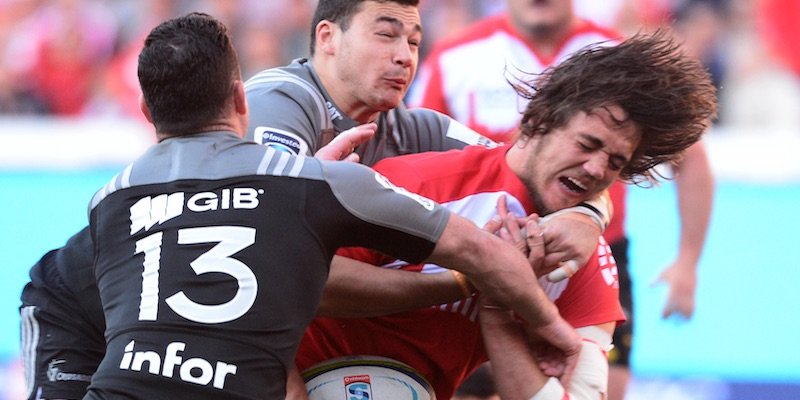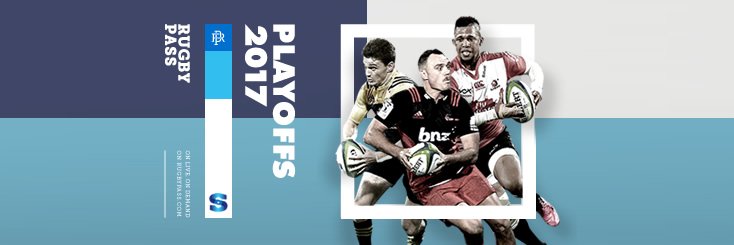Stats: Who Holds The Upper Hand Heading Into The Super Rugby Semifinals?

Just four teams remain in the hunt for the Super Rugby title. Scotty Stevenson breaks down the strengths and weaknesses of each of the semifinalists.
How do we judge which of the four Super Rugby semifinalists put up the best performance last week? For sheer scoreline, it’s hard to look past the Hurricanes who, in truly atrocious conditions, handed the Sharks a history making 41-zip hiding at the Caketin – the first time a team has been held scoreless in the playoffs. The Lions eased out to a 42-25 victory over the Crusaders who had no answer to the up-tempo game of the hosts, the Highlanders rode their TMO luck to hold on for dear life and emerge on the right side of a 15-9 slug-fest against the Brumbies, and the Chiefs embarrassed the Stormers, 60-21.
The Chiefs were simply too creative and too staunch to give the Stormers any chance of winning their quarterfinal at Newlands. Creativity has been a hallmark of this team all season long, and no player has been more creative than rookie of the year Damian McKenzie. McKenzie has carried the ball more and beaten more defenders than any other player this season, has made the second most offloads and clean breaks, and sits third in metres gained. He has been the click in the Chiefs click play but he wasn’t even in the top 25 players for carries or metres in the quarterfinals. That’s important as it shows there are other players in the backline who can spark the attack.
What is also important is that the Chiefs boasted nine players inside the top 25 tacklers of the round. Kane Hames led all players with 16 takedowns, while Dom Bird, Tom Sanders and Nathan Harris (12), Brodie Retallick and Anton Lienart-Brown (11), Brad Weber (10), Aaron Cruden and Atu Moli (9) all joined him on the list.
Sam Cane, who left the field for concussion protocol at the 40-minute mark, did not feature in the tackle count this week, but it pays to point out that Hames’ 16 tackles were made in just 60 minutes. To have the best attacker and best defender in the team overshadowed by other players in the biggest game of the season (and the Chiefs’ biggest score of the season) does plenty to illustrate the depth and desire in the side.
The Chiefs have plenty of that and will likely welcome back both Michael Leitch and Seta Tamanivalu, who combined for three tries in the Chiefs’ one-point win over the Hurricanes in Wellington in April – a game in which Leitch also made 14 tackles. That will be a big boost to the Chiefs who will be punished by the travel schedule and who also used a lot of gas in defence in Cape Town.
One thing the Hurricanes will have noted is that the Chiefs’ width defence needs some work. Toni Pulu and Sam McNicol each missed four tackles against the Stormers and Jaco Taute was allowed more running metres than any other player in the quarterfinals.
It is interesting to note that the Chiefs’ win in Wellington back in April came off the back of their worst metres run return of the season, and in a match in which they were forced to make twice as many tackles while managing just 40% possession. Against the Stormers the Chiefs were forced to make twice as many tackles and had just 40% possession. Coincidence?
The Hurricanes were a class above the Sharks in Wellington in apocalyptic capital weather, and the performance of TJ Perenara was arguably the most dominant of his Super Rugby career. Undoubtedly the semifinals will pit the four best halves combinations in the world against one another. The Perenara-Barrett pairing has been consistent all year, and was superb against the Sharks.
While Perenara topped all runners for the Hurricanes, it was the way in which he and Barrett combined in the kick game that really caught the eye. The pair combined for 23 kicks in play against the Sharks showing both an awareness of the weather and of the Sharks limited counter attack. They won’t have the same luxury against the Chiefs who return the ball far better than the Sharks, but their ability to find space and direct traffic with the boot is crucial.
The Hurricanes share one key benefit with the Chiefs in the fact that James Marshall and Barrett can each play first receiver. Aaron Cruden and Damian McKenzie have shown the benefits of the twin-pivot system all season long for the Chiefs in a much more pronounced way, but there is a danger in allowing Marshall too much time up from fullback. Marshall (mainly on kick return) carried more than any other Hurricane last week, and he and Barrett for 22 carries in total. The Chiefs will be aware of the danger of allowing either to run too much.
They will also be aware of the Hurricanes improved defence, which last week boasted 105 tackles at 94%. Granted, the Sharks are not the most elusive team in the competition, but the Hurricanes tackling average this year has been 85%, so the 94% return is a massive confidence boost. No team has managed to make that kind of tackling percentage this season.
And it’s not just in tackling percentage where the Hurricanes can dominate. No semifinal side has allowed fewer running metres this year, and no side has forced more tackles. The Hurricanes will make any side earn the yards, and the explosiveness of Ardie Savea, Vaea Fifita and and ever-improving Willis Halaholo keep defensive systems wary of over-stretching.
The Hurricanes have also become the masters of control: they boast the best ruck retention rate in the semifinals and retain more possession than all bar the Lions, with the lowest turnover rate – an important consideration against a counter-attacking team such as the Chiefs. The Hurricanes made 19 turnovers against the Chiefs in April, which cost them the game.
One other note on the Hurricanes: Cory Jane is often criticised for his lack of running game. On the weekend he posted exactly zero running metres. A word to the wise: Jane’s defensive ability and vision of the game means he shuts down his entire quarter of the field – teams won’t kick to him because they know the danger he poses.
The Lions were outstanding against the Crusaders who, as was predicted last week, struggled against the all-out attack of the South Africans. The Lions really are anathema to the traditional South African style of play but they deserve their hosting rights in the semifinal. They also deserve to be considered favourites against the defending champions.
This is the highest possession side in the semifinals against the lowest possession side in the semifinals. The Lions have made a season out of putting away the boot and attacking with ball in hand. As things stand they have scored more points and tries per game than any other side, run for more metres and beaten more defenders, made the fewest tackles and – counter-intuitively considering their low tackle count – made the most turnovers per game.
So far this season, opposition teams have kicked the least against the Lions, which could be considered the great sucker punch of the year. Whether the Highlanders fall into the same trap will be interesting, considering they produce more kicks in play than any other side. The Lions have rarely been tested on kick return – though they were against the Highlanders in the regular season and lost the match 15-34 despite having – and this is a scarcely believable stat – 71% of possession.
In truth, almost half of that possession was held inside their own half in that match, which the Highlanders will well remember heading into this knockout match. It pays to note that in all three of the Lions’ losses (all against New Zealand sides) the opposition kicked the ball more than the Lions’ opposition average this season. The Hurricanes, who gave the Lions their only genuine hiding of the season, kicked the ball 27 times against them, which is the average number of kicks the Highlanders have produced per game this season.
On the plus side for the Lions is the tireless defensive work of the likes of Franco Mostert (deservedly player of the match last week against the Crusaders), Warwick Tecklenberg and Malcolm Marx. Tecklenberg and Marx have combined for 24 turnovers won this season while Mostert leads all tacklers in the Lion side.
One weak link in the Lions defence is first five eighth Elton Jantjies who has slipped off 28 attempts this year. The Highlanders will attempt to exploit that channel this week. Despite the defensive frailty, Jantjies still combined well with mini-Fabio halfback Faf de Klerk and it is this halves combination that will have to produce on the level of Smith-Sopoaga if they want to succeed.
They could do worse than to give the ball as much as possible to right wing Ruan Combrinck who has been the breakthrough player of the year in South Africa. Combrinck’s duel with Patrick Osborne will be one of the best showdowns of the season.
The Highlanders have built their reputation on defence and that reputation was only enhanced in Canberra on Friday night when they tackled their way through the final ten minutes to book a semifinal in Johannesburg.
The Highlanders have become the masters at the scramble, missing more first up tackles than any other team in the semifinals, but somehow finding a way to still boast the best overall tackling percentage. The Highlanders, for all their flair, show a genuine patience for the best moments to attack, and rely on other teams’ mistakes for wins (they make the fewest turnovers in the competition). They also are stingy, conceding the fewest points per game this season and the fewest tries.
That’s not to say this is a team that cannot attack, but the fact is they have also scored fewer points and fewer tries than any other semifinal side. They also carry the ball the least, make the fewest run metres, the fewest breaks, beat the fewest defenders and boast the fewest rucks. Only the Kings spent less time with the ball this season and that was because they had no idea what to do with it.
For all their lack of possession and their game-of-chicken approach, the Highlanders do have one ace up their attacking sleeve and that is their offload game, led by Malakai Fekitoa, which has punished teams all season. The Highlanders axis of attack – Aaron Smith, Lima Sopoaga and Ben Smith – provides a shepherding quality to force players into support positions which, when it works, has led to some of the most breathless moments of the season. When it doesn’t, it leads to more turnovers per game than any other team.
The Lions will have to be aware of the workrate of Lima Sopoaga who carried more than any other player against the Brumbies. That is expecially relevant given his opposite Elton Jantjies’ missed tackle count this season. There is also the dual threat posed by Patrick Osborne and Waisake Naholo who receive the ball more than any other wing combination in the competition.
If the Highlanders can play kick-and-stick again this weekend then there is no reason they can’t emerge victorious against the Lions. The only question is whether their scramble can hold out for another week.
















































